 Taking paid and unpaid work time together, working-age American men and women differ very little in their total work time. Analyses of pooled data from the American Time Use Survey of 2003 to 2011 indicate that on average, men spend about 10 hours more than women per week in paid work, although women spend about six hours more than men in household work and about three additional hours in child care, bringing the total work time to 45.6 hours per week for men and 45.2 hours for women.
Taking paid and unpaid work time together, working-age American men and women differ very little in their total work time. Analyses of pooled data from the American Time Use Survey of 2003 to 2011 indicate that on average, men spend about 10 hours more than women per week in paid work, although women spend about six hours more than men in household work and about three additional hours in child care, bringing the total work time to 45.6 hours per week for men and 45.2 hours for women.
However, men spend more time than women in leisure activities, which includes TV time, playing games, sports and a series of other activities.27 The gender gap in leisure is about five hours per week.
Having children at home changes people’s time use patterns. Men who have kids spend more hours in paid work, while the opposite is true for women. Fathers with children under age 18 on average spend 38 hours per week in paid work, seven hours more than the amount of paid work time spent by men who do not have children at home, yet mothers spend less time in paid work than working-age women without children at home (22 hours per week vs. 25 hours).
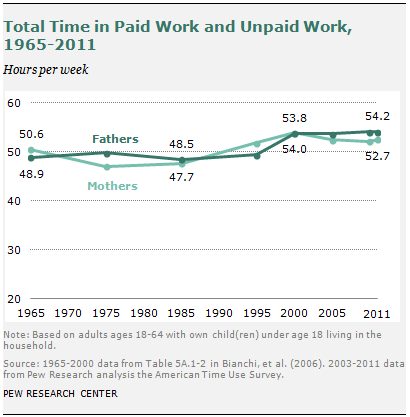 Despite the fact that mothers still do more housework and child care than fathers, fathers’ overall work time (including unpaid work at home) is actually two hours more than that of mothers. Fathers also enjoy more leisure time than mothers; the gap is close to three hours per week. For adults who do not have young children at home, the gender gap for total work time is minimal, although the leisure gap is wider: men without young children at home spend about five hours per week more in leisure than women in the same situation.
Despite the fact that mothers still do more housework and child care than fathers, fathers’ overall work time (including unpaid work at home) is actually two hours more than that of mothers. Fathers also enjoy more leisure time than mothers; the gap is close to three hours per week. For adults who do not have young children at home, the gender gap for total work time is minimal, although the leisure gap is wider: men without young children at home spend about five hours per week more in leisure than women in the same situation.
Since the mid-1960s, the total work time for parents has increased slightly, and the gap between fathers and mothers is fairly small. In 1965, working-age fathers spent about 49 hours per week in paid and unpaid work combined; mothers spent 51 hours per week.
However, the allocation of work time for mothers and fathers has changed dramatically. In 1965, 83% of mothers’ work time was spent doing housework and caring for children; the share of unpaid work for fathers was only 14%. More than four decades later, fathers’ overall work time has increased to about 54 hours per week; their share of unpaid work is about 31%. Mother’s total work time has also slightly increased to nearly 53 hours per week in 2011, but their share of unpaid work has dropped to about 60%.
Fathers and Mothers in Different Family Settings
While overall marriage rates have fallen significantly, most parents with children at home are married. According to 2003 to 2011 pooled ATUS data, about 80% of parents ages 18 to 64 with children younger than 18 are married and living with a spouse, an additional 16% of parents are not, and about 4% of parents live with a partner. Fathers are more likely than mothers to be married and living with a spouse.
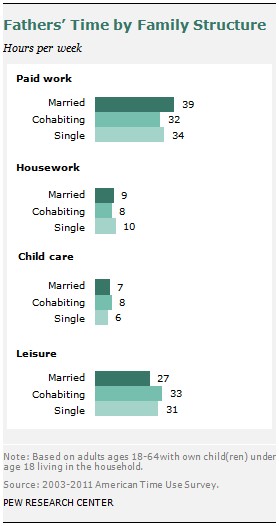
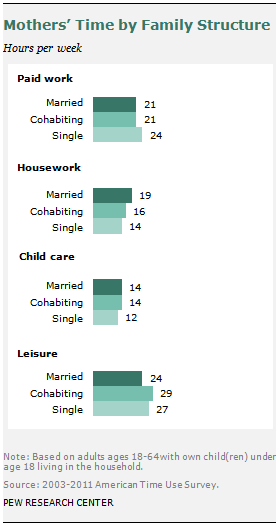 Compared with single fathers and fathers who live with a partner, married fathers work the longest hours and enjoy the least amount of leisure time. Their time in housework and child care is relatively high as well. Single fathers spend 10 hours per week in housework (similar to married fathers) but less time in child care than men who are married or cohabiting. Fathers living with a partner have the most leisure time, averaging 33 hours per week.
Compared with single fathers and fathers who live with a partner, married fathers work the longest hours and enjoy the least amount of leisure time. Their time in housework and child care is relatively high as well. Single fathers spend 10 hours per week in housework (similar to married fathers) but less time in child care than men who are married or cohabiting. Fathers living with a partner have the most leisure time, averaging 33 hours per week.
Similar to married fathers, married mothers spend less leisure time than do mothers in other family settings. Married mothers spend the longest time in housework (19 hours per week), compared with single mothers (14 hours) or mothers living with a partner (16 hours). Single mothers spend less time in child care than do married or cohabiting mothers, but their hours at paid work are longer than for mothers in other family settings.
Gender Gap among Married or Cohabiting Couples
Parents who live with a partner are a small minority of parents (4%). Compared with married couples, cohabiting couples are younger, less educated and less likely to be employed. They also have fewer children at home than married couples, and their kids are a bit younger.28
Using the yardstick of overall workload, married couples with children are more egalitarian than cohabiting couples. On average, married fathers’ time in paid and unpaid work totals 55.5 hours per week, 1.4 hours more than that of married mothers. The total work hours for cohabiting fathers are almost three hours less than those of cohabiting mothers.
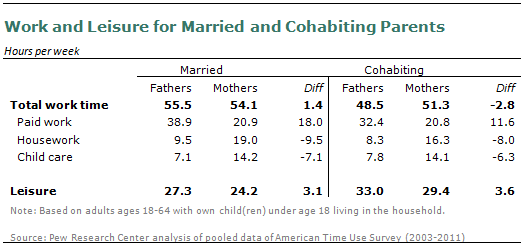
Compared with cohabiting couples, married couples seem to be more “specialized” in allocating their time: Dads spend more time in paid work, and moms take over more housework and child care. Married dads spend 18 hours per week more in paid work than do married moms, and in return, moms spend about 10 hours more in housework and seven hours more in child care, which brings the total work time of married dads to about one hour per week more than moms.
Fathers living with a partner spend much less time at paid work than do married fathers, but mothers who cohabit spend about the same amount of time in paid work as married mothers. The result is in a gender gap in paid work among cohabiting couples that is lower than it is among married couples. Cohabiting mothers spend less time than married mothers in housework (16 hours per week vs. 19 hours), but their child care time is about the same. Cohabiting mothers’ longer hours in child care and housework are not offset by longer paid work hours from their partners, and therefore the gender gap of total work time among cohabiting couples is actually larger.
Fathers have more leisure time than their partners, regardless of marital status.
How Do Couples View the Division of Labor at Home?
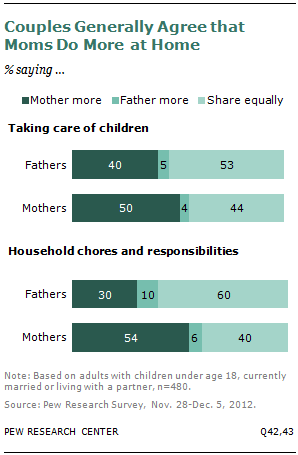 Time use data show that among married and cohabiting couples with children, mothers spend about twice as much time as fathers in housework and child care. Findings from the public opinion survey indicate that couples generally have a good sense of who does more at home.
Time use data show that among married and cohabiting couples with children, mothers spend about twice as much time as fathers in housework and child care. Findings from the public opinion survey indicate that couples generally have a good sense of who does more at home.
When asked how child care work is divided at home, four-in-ten fathers acknowledge that their partners usually do more than they do: only 5% say that they do more child care than their partners. Half of mothers say that they do more than their partners; only 4% say their partners do more child care. About half of fathers (53%) say that they share the child care responsibilities equally with their partners, compared with 44% of mothers.
Fathers and mothers seem to be less in agreement over who takes on more household chores and responsibilities. Three-in-ten fathers say that their partners do more housework than they do, and one-in-ten say they do more housework than their partners. A higher share of mothers (54%) say they are the ones who do more household chores; only 6% say their partners do more.
From fathers’ perspectives, housework is more of a shared task. Six-in-ten fathers who are married or living with a partner say that they share the household chores and responsibilities equally with their partners; 40% of mothers say the same.
Dual-Earner Couples
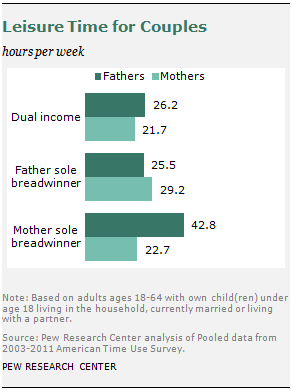 Among working-age parents with young children who are either married or living with a partner, a majority (59%) are dual-income couples and an additional 32% fall in the pattern of “Ozzie and Harriet” where dad is the breadwinner and mom is the homemaker. About 6% of couples have reversed the traditional model with mothers becoming the sole provider for the family. For a small group of couples (3%), neither parent works for pay.29
Among working-age parents with young children who are either married or living with a partner, a majority (59%) are dual-income couples and an additional 32% fall in the pattern of “Ozzie and Harriet” where dad is the breadwinner and mom is the homemaker. About 6% of couples have reversed the traditional model with mothers becoming the sole provider for the family. For a small group of couples (3%), neither parent works for pay.29
Since both partners need to juggle work and home responsibilities, the overall work time among dual-earner couples is fairly even: 58 hours per week for fathers and 58.6 hours for mothers. Dual-income couples do not necessarily divide up their work in a 50-50 way. Fathers spend about 42 hours per week at the paid work, nearly 11 hours more than mothers. Mothers, instead, spend longer hours in child care and housework than fathers. However, fathers in dual-income households have more leisure time than mothers, so the gap is 4.5 hours per week.
One reason that working mothers log in less time at paid work is that they are much more likely than fathers to work part time. In 2011, only about 7% fathers ages 18 to 65 worked part time, compared with about 27% of mothers.30
Stay-at-Home Dads vs. Stay-at-Home Moms
Stay-at-home dads are much less common than stay-at-home moms. Only about 6% of fathers who are married or living with a partner stay at home and take care of kids and the house, compared with 30% of mothers in a similar arrangement. Compared with fathers who are either in dual-earner arrangements or are the sole earner for the family, stay-at-home fathers are slightly older (the average age is 41), less likely to be white and college educated. Stay-at-home mothers are slightly younger than mothers who work for pay (age 36 vs. 38), they tend to have more children and their children are younger as well.31
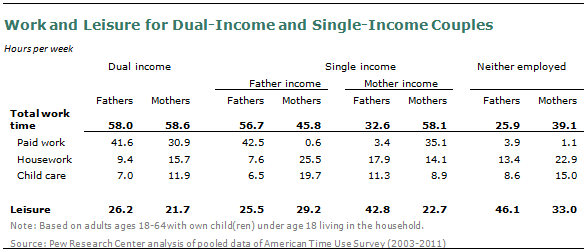
When mothers are the sole breadwinner in the family, they spend about 25 hours more per week in total work time, but 20 hours less in leisure than their non-employed partners. In contrast, when working fathers are the sole breadwinners, their overall work time is about 11 hours per week more than their partners, and their leisure time is about four hours less than their partners.
Stay-at-home fathers help out more in housework and child care than do working fathers. They average about 18 hours per week in doing housework and 11 hours in taking care of the kids, the highest levels of all fathers. Their housework and child care hours are longer than their partners’, although the difference is not big. Stay-at-home fathers spend about four hours more per week than their working partners in housework, and about two hours more per week in child care. Yet their leisure time is nearly double that of their partners (43 hours per week vs. 23 hours).
In contrast, when moms stay at home and dads work for pay, they average about 26 hours per week in housework and about 20 hours in child care, more than three times as much as what their working partners put into these activities. Stay-at-home mothers have more leisure time than their partners who work for pay, but only by less than four hours.
For a small group of couples with kids, neither partner works for pay (about 3% from 2003 to 2011). Interestingly, when there is no obligation of paid work for either partner, mothers still spend nearly twice as much as time in housework and child care work than do fathers (38 hours per week vs. 22 hours).
Free Time: Delusion or Real Deal?
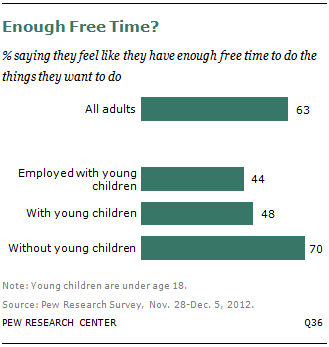 Free time is usually measured by the residual time after subtracting time spent in paid work, housework, child care, commuting and personal care, while leisure time is more about time spent in activities that relate to relaxation. Between 2003 and 2008, fathers had on average 32 hours per week of free time; mothers had 31 hours.32 Fathers also had more leisure time than mothers, as discussed earlier in the chapter using 2003 to 2011 ATUS: On average, fathers spend about 28 hours per week on leisure activities, roughly three hours more than mothers.
Free time is usually measured by the residual time after subtracting time spent in paid work, housework, child care, commuting and personal care, while leisure time is more about time spent in activities that relate to relaxation. Between 2003 and 2008, fathers had on average 32 hours per week of free time; mothers had 31 hours.32 Fathers also had more leisure time than mothers, as discussed earlier in the chapter using 2003 to 2011 ATUS: On average, fathers spend about 28 hours per week on leisure activities, roughly three hours more than mothers.
Fathers and mothers seem to experience their free time differently. Mothers’ free time is often interrupted, which may make it hard for them to relax (Bianchi, et al. 2006; Mattingly & Bianchi 2003). Moreover, mothers tend to spend more time than fathers in multitasking; the additional hours spent on multitasking are mainly related to time spent on housework and child care (Offer & Schneider 2011).
The recent Pew Research survey asked respondents whether or not they felt they had enough free time to do the things they want to do. Surprisingly, no gender differences are found about how men and women evaluate their free time, nor did fathers and mothers differ in their views. More than six-in-ten adults say that generally they feel like they have enough free time to do the things they want to do.
Adults ages 65 or older are more likely than adults at younger ages to say that they have enough free time, and the adults in their 30s and 40s are the least likely to say so. About eight-in-ten adults ages 65 and older (83%) say that they have enough free time to do the things they want to do, compared with 63% of adults ages 18 to 29, 64% of those ages 50 to 64 and 52% of those ages 30 to 49.
Having young children is associated with how people feel about their free time. Seven-in-ten adults who do not have children under age 18 say that they have enough free time, compared with 48% of adults with young children. Some 72% of adults with grown children over ages 18 feel that they have enough free time to do the things they want to do.
Unmarried parents are more likely than married parents to say that they do not have enough time to do the things they want to do. And working parents with young children feel a lack of free time: More than half (55%) say they do not have enough free time, and 44% say that they do. Employed fathers and mothers view their free time similarly.


 Quiz Which Parent Does More in Your Home?
Quiz Which Parent Does More in Your Home?